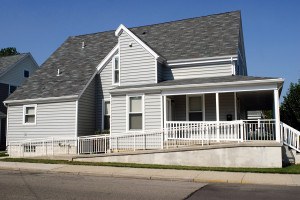Part One: Creating an Accurate Scope
Although the provision of home modifications for a claimant is usually a small part of a much more expansive claim, it can represent a significant financial burden if not completed appropriately. Managing the cost of any construction project can be challenging however the home modification project associated with a workers’ compensation claim has many influential factors that can challenge even the most seasoned professional. Cost containment shouldn’t necessarily be the primary aim, rather cost containment should be the by-product of an otherwise healthy home modification process.
 For many carriers, claims that require significant home modifications are not a frequent event and therefore little time or effort has been given to establish internal protocols. When they occur, a scramble ensues and employees that are highly skilled with understanding policies and claims management are asked to make sense of scope, designs, costs and production of the construction of modifications. Many senior claims professionals have expressed their frustration and anxiety with the responsibility, inconsistency, cost and risk associated with modifications. While there is no magic potion to make the process perfect, there is a simple formula that if followed, can reduce risk, contain cost and improve outcomes.
For many carriers, claims that require significant home modifications are not a frequent event and therefore little time or effort has been given to establish internal protocols. When they occur, a scramble ensues and employees that are highly skilled with understanding policies and claims management are asked to make sense of scope, designs, costs and production of the construction of modifications. Many senior claims professionals have expressed their frustration and anxiety with the responsibility, inconsistency, cost and risk associated with modifications. While there is no magic potion to make the process perfect, there is a simple formula that if followed, can reduce risk, contain cost and improve outcomes.
Cost Containment = Accurate scope + Reasonable Price + Time Efficiency
In this three part series we will take closer look at each addend in the equation individually. While an entire book could be written on each component, we will highlight the most common applications. Each component can stand alone; however each component depends on the other for a successful outcome.
When discussing cost containment, most assume we’re talking about cost reduction. Cost containment doesn’t always mean cost reduction. Cost containment and cost reduction only coincide when you’re overpaying. As defined in Webster’s Dictionary, “containment” means to prevent the expansion of something. Cost containment literally means preventing the “expansion” of the cost of the job. It only becomes cost reduction if you’re overpaying and able to bring the cost down into a reasonable range.
Unfortunately, too often the industry (in general) has taken the approach that cost reduction means beating down (negotiating) contractors and vendors on their pricing. While this might have some initial impact on the bottom line, there is usually an equal unintended consequence and it’s commonly related to the end quality of product or services. After years of experience and observation, I believe that most excessive cost issues aren’t related to the price of the product or service, but rather the amount of product or service being authorized. Simply said, with modifications, it’s not the price that is the issue, it’s the scope of work. After all, the scope of authorized work is what drives the total cost of the job. Carriers often pay for unnecessary and unreasonable items because they’re told by “professionals” that they’re necessary.
The foundation for a successful project starts with an accurate scope of work. An accurate scope of work is the direct result of obtaining a skilled and accurate home assessment. While every claimant is different and every home unique, there are four common guidelines you might consider when establishing the scope:
A. An accurate scope recommends modifications that enable the claimant to obtain the necessary level of functional independence within their living environment or it creates an environment that provides the space and resources necessary for the claimant’s provision of care.
B. An accurate scope focuses on functional outcomes and safety precautions not only for the claimant, but for those living in the home and those assisting with primary care responsibilities.
C. An accurate scope does not entitle the injured worker or their family to remodel their homes or upgrade their living standards unless it is directly related to the functional or medical necessity of the claimant.
D. An accurate scope includes recommendations that either improve functional outcomes, prevents deterioration or reduces risk.
While these guidelines are important, they’re not effective unless the person completing the initial assessment has skilled knowledge of the current medical and functional status, the expected outcomes, and the common long term progression of the medical condition.
Finding the right professional is not always easy. There’s no professional license or accreditation required to be an accessibility specialist. In reality, anyone could wake up tomorrow morning, have some business cards printed and label themselves as an accessibility specialist and begin marketing their services. It’s scary but true. So who can you call when the need arises? Contractors and occupational therapists are most commonly used; however, case managers and non-licensed individuals are also hired to complete assessments and make recommendations. The accessibility market is becoming flooded with people seeking fortune on the silver wave of the aging population. As a result, there are many unqualified individuals competing for business. That being said, there are also very qualified individuals in each of these fields that could be appropriate for your project. It’s important is to be aware of the strengths and specialized knowledge that each bring to the project.
A contractor has good working knowledge of structure and building components, however they seldom have the education or skill to understand the injury and specific functional requirements of the claimant. As a result, contractors often defer to using the Americans with Disabilities Act regulations or Universal Design as their guidelines rather than considering the customization to the specific needs of the claimant.
In a recent assignment, we were asked to review an estimate submitted by a contractor for modifications at the home of a claimant that had sustained a thoracic level spinal cord injury with permanent paraplegia. Among many other items, the contractor’s recommendation included lowering every light switch in the house and changing every door knob and faucet in the home to a lever handle. The modifications were based on his “working knowledge” of the ADA. As a result, the estimate added up significantly. The primary issue with the estimate was that the scope was inaccurate for the claimant’s functional abilities. The claimant had no upper extremity functional loss and no grip or reach deficits. Therefore it wasn’t necessary to lower light switches or use lever handles. The contractors estimate came in very high not because he charged too much to move a light switch or switch out a handle, but because he shouldn’t have included light switches and lever handles at all.
An occupational therapist should have a good working knowledge of functional outcomes and the progression of the medical conditions. However, few have skilled knowledge about construction or design. When reviewing home assessments completed by therapists, it’s common to see a general recommendation like “modify the bathroom for wheelchair accessibility”. While this might be a general concept, there are many ways to modify a bathroom. The recommendation might be more specific, “modify the bathroom with a roll-in shower”. Again, although more specific, there are many ways to build a roll-in shower. When a non-specific recommendation is provided, it leaves the discretion up to the contractor as to how it will be constructed. You could assign three contractors to provide three bids on the recommendations and be presented with three completely different designs and no guarantee that any will be appropriate. Many occupational therapists are hospital-based and their primary practice is rehabilitation. Therefore, home assessment is simply an occasional part of their treatment plan rather than a specialty. However, there are occupational therapists that specifically specialize in home modifications.
Creating a truly appropriate scope is a collaborative process. The accessibility specialist’s responsibility isn’t to tell the carrier what has to be done, rather it’s their responsibility to tell the carrier what can be done and provide them with options. With a good assessment and recommendations, the carrier can then decide what modifications meet their medical necessity model under the provision of the policy and state regulations. Once the carrier determines what modifications are necessary, the agreed scope of work can be presented to the contractor to create a cost estimate.
An accurate scope takes many things into consideration that are directly and indirectly related to the claimant. However the one commonality is that all modifications provided have to be determined to be medically necessary. In our practice we like to use the term functionally necessary as well. We use the term because it’s the injured worker’s functional abilities that are the foundation on which we establish recommendations to achieve the highest outcomes. Unfortunately, defining medical necessity is challenging and many hours in litigation occur debating its definition and application to specific claims. Although there is no absolute definition of medical necessity, there are three commonalities of most:
- The services must be consistent with the injured worker’s medical condition, diagnosis or injury.
- The services must be in accordance with accepted standards of medical practice.
- The services must not be solely based on convenience for the injured worker or caregiver.
When applied to home modifications the commonalities are similar:
- The modifications must be consistent the injured worker’s functional abilities.
- The modifications must be in accordance with accepted standards of construction code.
- The modifications must not be solely based on convenience for the injured worker or caregiver.
- The modifications must be directed toward specific desired outcomes.
While home modification projects can be expensive, containing the cost can be achieved. The first step in the process is to establish an accurate scope. By understanding a simple formula, following simple guidelines and working with skilled professionals the appropriate recommendations can be considered and an accurate scope can be achieved.
In the next part, we’ll discuss the second part of the formula, “reasonable price”. In that article you’ll learn how to standardize the pricing structure to ensure measurable and reasonable pricing.
By Corey Staver, OTR, CHAMP, CAPS
CEO David Corey Company, a full service home modification company that provides skilled home assessments by occupational therapists.
Was this article valuable?
Here are more articles you may enjoy.

 Supplemental Claims Don’t Need to Include Damage Estimates, Fed Appeals Court Says
Supplemental Claims Don’t Need to Include Damage Estimates, Fed Appeals Court Says  Viewpoint: The Impact of Behavioral Health on Workers’ Comp
Viewpoint: The Impact of Behavioral Health on Workers’ Comp  Beyond the Claim: How Social Canvassing is Transforming Insurance Fraud Detection
Beyond the Claim: How Social Canvassing is Transforming Insurance Fraud Detection  Zurich, Philadelphia, Others Ordered to Pay $345M to Cover Abuse Charges at Georgia School
Zurich, Philadelphia, Others Ordered to Pay $345M to Cover Abuse Charges at Georgia School 